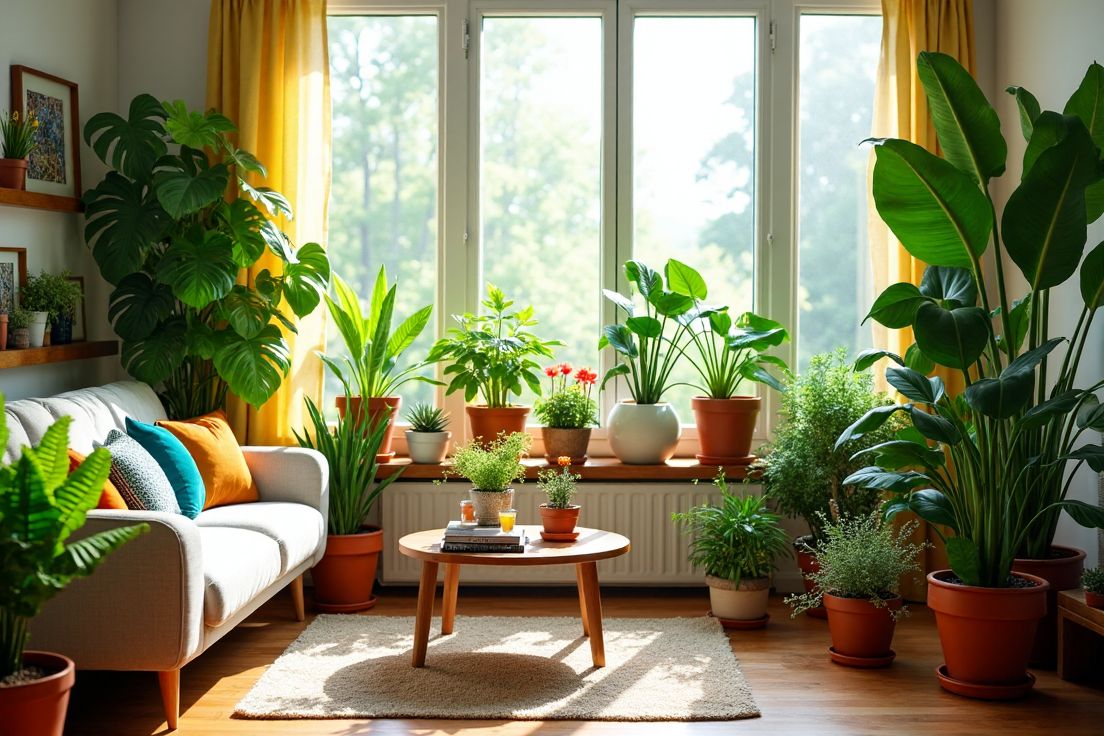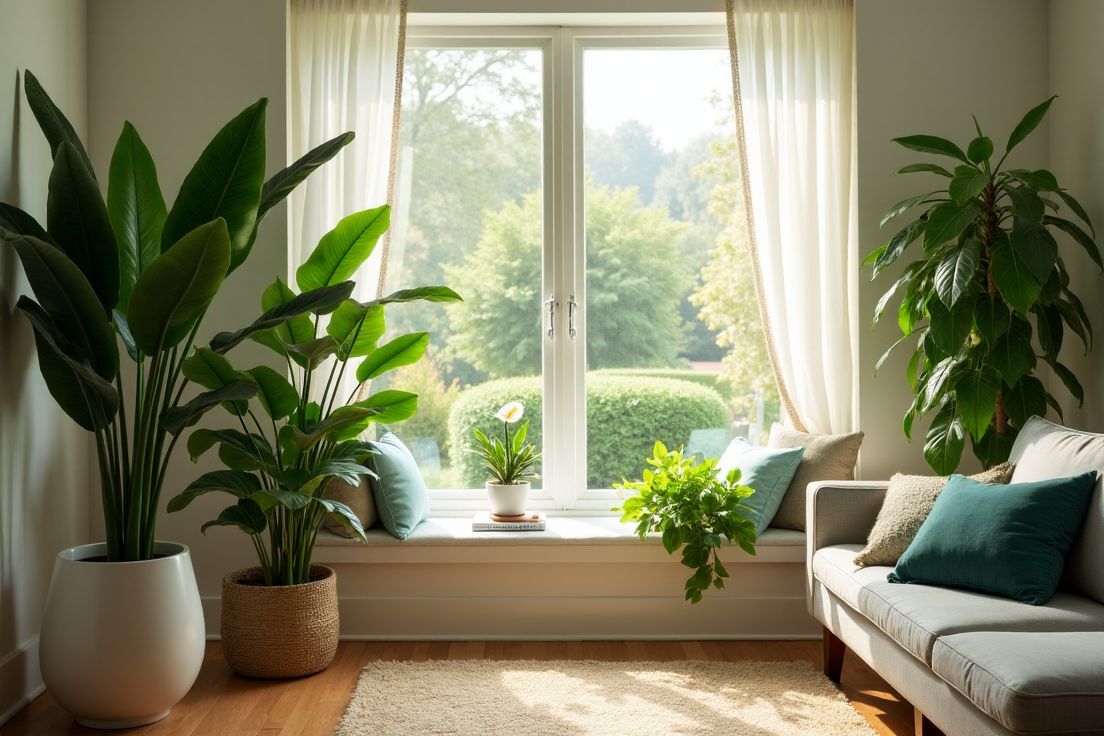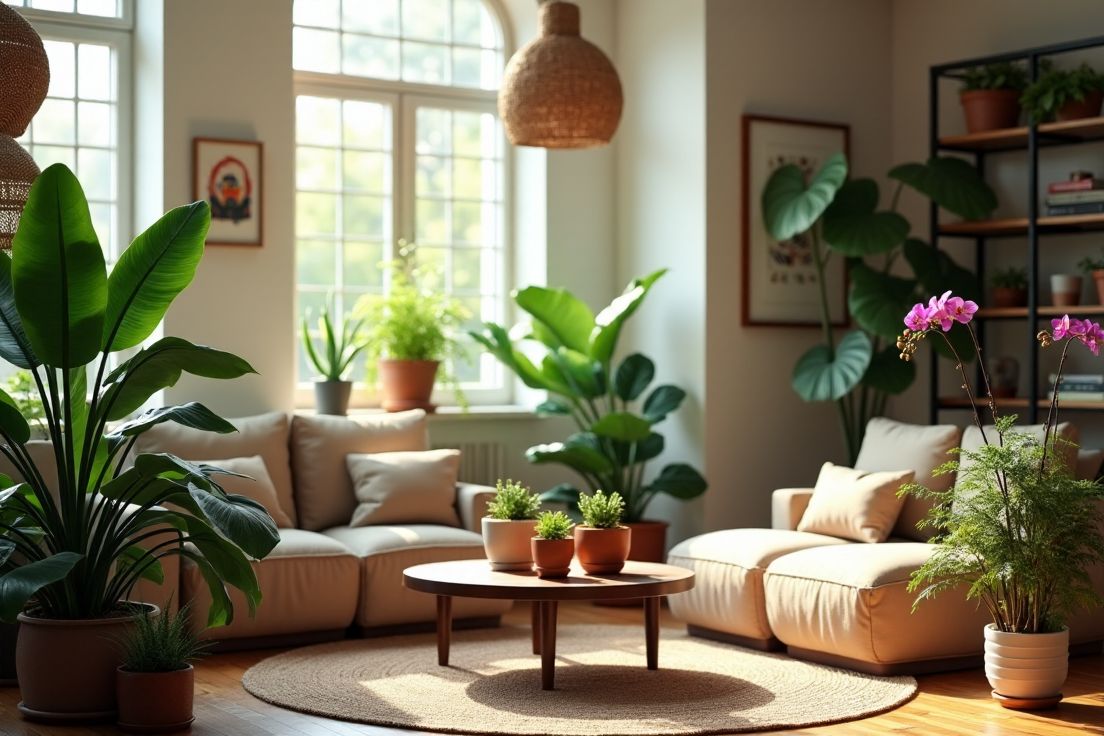Potted plants can bring life and beauty into any space. When choosing the right plants for your home, it’s essential to think about several factors, including light levels and the size of your area. Each plant has its own needs, and selecting the best ones will help them thrive in their new environment.
In this guide, we will explore how to pick the ideal potted plants that match your lifestyle and decor. From beautiful succulents to vibrant ferns, there’s a perfect plant for every room. Let’s dive into the world of potted plants and discover how to make your space greener and more inviting!
Selecting Ideal Potted Plants for Your Environment

When picking potted plants, consider how much light your space gets. Some plants thrive in bright sunlight, while others prefer the shade. If your room is dark, low-light plants like pothos or snake plants can flourish there.
Also, think about the size of your space.
When selecting potted plants for your space, it’s important to consider the light conditions and size of the area. Below is a table highlighting different plants based on their light requirements and size suitability.
| Plant Name | Light Requirement | Size Suitability |
|---|---|---|
| Pothos | Low Light | Small to Medium |
| Snake Plant | Low to Bright Indirect Light | Small to Large |
| Spider Plant | Bright Indirect Light | Medium |
| Fiddle Leaf Fig | Bright Indirect Light | Large |
| ZZ Plant | Low Light | Small to Medium |
| Succulents | Bright Direct Light | Small |
Large plants can be stunning but might overwhelm a small area. For corners or shelves, smaller varieties can add charm without taking up too much room. Remember to consider the height and spread of the plant as it grows.
Another important factor is your lifestyle.
If youre busy, opt for low-maintenance plants that dont need daily attention. Succulents and cacti are great options for those who want something beautiful without the hassle. If you enjoy gardening, you might prefer more demanding species that provide a rewarding challenge.
It’s also fun to mix different textures and colors.
Choose plants with varying leaf shapes and shades to create visual interest. Pair leafy plants with flowering species for a vibrant display. Just ensure that they have similar light and watering needs for harmony.
Finally, think about the pots themselves.
Diverse Plant Selections for Varying Light Conditions
Choosing the right plants not only enhances the look of your space but also ensures that your plants thrive in their environment. For spaces flooded with sunlight, options like succulents and cacti are excellent choices. These plants do well under bright, direct sunlight and can add beauty with their unique shapes and colors. They require minimal watering, making them practical for sunny areas.
In areas with abundant indirect light, plants such as the fiddle leaf fig and spider plant work beautifully. They can grow tall and leafy, making them eye-catching centerpieces that bring life to your room. Providing them with just the right amount of light keeps their leaves vibrant and healthy.
For darker spots, low-light lovers like the ZZ plant and snake plant shine.
They require very little light to survive and can thrive in conditions where other plants might struggle. Their hardiness makes them great for beginners or for those who may forget to water periodically.
Consider rotating your plants occasionally to ensure they receive sunlight evenly. This practice promotes balanced growth and helps avoid uneven leggy stems, which can detract from their appearance.
Additionally, grouping plants with similar light requirements can create a harmonious and attractive display.
Understanding the Maintenance Needs of Various Potted Plants
Different plants have unique maintenance needs, making it important to know what each type requires for optimal growth. For instance, succulents, such as jade plants and aloe vera, thrive in dry conditions and need infrequent watering. It’s essential to let the soil dry out completely between waterings to prevent root rot.
On the other hand, tropical plants like pothos and fiddle leaf figs appreciate higher humidity and more regular watering.
These plants like to be kept moist, but its crucial not to let them sit in water, which can cause their roots to drown.
Additionally, some plants, such as snake plants and ZZ plants, are known for their hardiness. They can tolerate neglect and lower light levels, making them perfect for busy individuals. Less frequent watering is a must for these types, as they can survive with minimal attention.
Fertilizing also varies among plant types. Fast-growing species, such as spider plants, may need to be fed every month during the growing season, while others may require little to no fertilization. Understanding specific fertilizer needs can help plants flourish without overwhelming them.
Another consideration includes pruning and repotting.
Some plants may outgrow their containers and require repotting every couple of years to provide more space for roots. Pruning helps to control their shape and encourage fuller growth. Knowing when and how to prune is key to keeping plants healthy.
Air circulation is also essential.
Maintaining healthy plants involves several key practices to ensure they grow strong and thrive. Below are important points to consider when caring for your plants:
- Repot every couple of years to provide adequate space for root growth.
- Regular pruning promotes healthier, fuller growth and maintains shape.
- Use clean, sharp tools to avoid damaging plants during pruning.
- Monitor for signs of root crowding, such as slowed growth or roots emerging from the pot.
- Ensure adequate air circulation to prevent mold and mildew, promoting overall plant health.
Choosing the Right Plant Size for Your Space
Assessing the appropriate size and scale of plants is key to achieving a balanced and appealing space. First, take a close look at the dimensions of the area where you plan to place the plants. Tall, slender plants can fit neatly in corners or next to furniture, while wider plants may require open spaces to make a statement without feeling cramped.
Consider not only the plant’s current size but also its potential growth.
Some species may start small but can grow significantly over time. Understanding the mature height and width will help you avoid overcrowding your space. Be mindful of ceiling heights, especially in rooms with low ceilings; you wouldn’t want a plant to compete for space with light fixtures or ceiling fans.
Placement also plays a crucial role.
For shelves or tables, select smaller, compact varieties that can add flair without overwhelming the tabletop. Grouping various sizes together can create visual layers, making the arrangement more dynamic. This adds depth, especially in larger rooms where you can use various heights to draw the eye upward and around.
Additionally, the color palette of your plants should harmonize with the room’s design.
Larger plants can act as focal points while smaller ones can gently complement the overall aesthetics. Accessorizing with decorative pots can further enhance the look, making each plant part of the decor.
Finally, don’t overlook how the plant’s scale interacts with other furniture or decor items. A large, leafy fiddle leaf fig might dominate a minimalist room, while several smaller plants can fill a more crowded space without competing for attention.
Keeping these aspects in mind will ensure that your greenery beautifully enhances your interior design.
Selecting Ideal Potted Plants for Your Environment

When it comes to enhancing your home with potted plants, consider how they can fit into your existing decor. The colors of the foliage should complement the shades present in your room. For example, vibrant greens can uplift a neutral space, while deep burgundies or variegated leaves add richness to a colorful area. Mixing and matching pots can also create a layered look.
Using different textures and materialslike ceramic, terracotta, or metalcan provide contrast, making displays more dynamic.
Another aspect to ponder is the function of the plants in your area. If you want to create a cozy nook, use smaller plants in softer tones that can maintain a calm atmosphere. Bold, larger plants can become central pieces in open spaces, drawing attention and creating a focal point in your room.
Consider grouping plants with similar characteristics to build a cohesive display that resonates with your style.
Think about functionality as well. If your plants are placed in frequently used areas, like a kitchen or workspace, consider their air-purifying qualities. Some plants not only look good but also help improve indoor air quality, making them practical selections for those spots.
Light and Size Considerations
The relationship between light and size is crucial when integrating potted plants into your decor. Different plants come with specific light needs, and understanding these can help you choose the right size for your space. When a plant doesnt get enough light, it can become leggy or fail to thrive, which detracts from its appearance.
Larger plants may require more light, so placing them in brighter spots will ensure they develop well.
However, if you opt for smaller plants, they can often thrive in lower light areas as long as you pick the right species. Its essential to think about how much direct sunlight your space receives throughout the day. For example, small succulents flourish in direct sunlight, but if you choose a larger plant like a fiddle leaf fig, it typically needs a spot with ample indirect light.
Moreover, when you decorate, consider how the size of the plant can influence the room’s overall look.
A large plant can serve as a focal point, while smaller plants can complement other decorations or furniture without overwhelming the space. Positioning these plants thoughtfully can create balance and harmony in your environment.
Keep in mind the growth potential of your plants. Choose locations where they can be displayed without obstruction and have ample space to grow.
Choosing Based on Your Environment
When selecting potted plants, consider the unique characteristics of the space where they will live. Different areas in your home can have various conditions, which play a big role in the choice of plants. For example, kitchens can get steamy and may have more humidity, making them suitable for tropical plants like ferns or peace lilies. These plants thrive in such environments and can enhance your kitchens atmosphere.
In contrast, a bright living room may benefit from larger plants like a fiddle leaf fig. This plant not only adds height and drama but also thrives on the natural light commonly found in these spaces. On the other hand, home offices or bedrooms might not receive as much light throughout the day. In these cases, low-light plants such as snake plants or ZZ plants are ideal, as they require minimal sunlight and still look good.
Outdoor spaces are another consideration. If you’re placing plants on a patio or balcony, think about how exposure to the elements can impact plant choice. Some plants tolerate direct sunlight and wind better than others. For example, certain succulents or herbs like rosemary can flourish in these conditions, adding greenery without much fuss.
Matching Plant Aesthetics to Your Interior Design Style
Choosing plants that fit well with your room’s design can create a more inviting atmosphere. Start by looking at your interior style. For a modern space, sleek pots and minimalist plants like snake plants or succulents may be the best fit. Their clean lines can enhance a contemporary environment.
If your home features traditional decor, consider plants with classic appeal. Larger leafy plants, like fiddle leaf figs, can add a touch of elegance. Pair them with ceramic or terracotta pots that evoke a timeless feel. This combination can make your space feel more inviting and warm.
For an eclectic style, variety is key. Mix and match different plants and pots. Use bright colors and unique shapes to add character to your space. A mix of textures, like soft ferns alongside spiky succulents, can make your arrangement pop.
In a rustic or farmhouse setting, opt for plants that reflect a natural aesthetic. Herbs like rosemary and thyme can be both practical and beautiful, especially in charming pots. Natural wood or woven baskets as plant containers can enhance the cozy vibe.
Lastly, think about how the color of your plants and pots ties into your decor.
Selecting Ideal Potted Plants for Your Environment

When selecting potted plants, it’s essential to think about how they will look in your space. Start by considering the colors and styles that fit your interior design. Plants with vibrant green leaves can liven up a neutral room, while darker foliage can add sophistication to more colorful designs. Mixing different plant shapes and pot styles can create a visually interesting display.
The function of your plants is also important. If youre aiming to create a cozy hideaway, smaller plants may work well to maintain a relaxed vibe. Bold plants can act as stunning focal points in open areas, drawing the eye and enhancing the room’s character.
Consider placing air-purifying plants in frequently used spaces like kitchens or work areas.
Their ability to improve air quality adds extra value along with their beauty. If you have pets, be sure to choose non-toxic varieties to keep every member of your household safe.
Also, think about the textures of the plants and pots. Using materials like ceramic or metal can add contrast and depth to your displays.
The combination of soft leaves and hard surfaces can create a balanced look that enhances the overall aesthetic.
Lastly, arrange your plants at different heights to create layers. This can make your setup feel dynamic and interesting. A tall plant can stand proudly alongside smaller varieties, ensuring your space has depth while drawing attention to all your greenery.
Frequently Asked Questions
Here are some frequently asked questions about selecting the right potted plants for your environment:
What factors should I consider when choosing potted plants for my space?
When selecting potted plants, consider the amount of light your space receives, the size of the area, your maintenance preferences, and the overall aesthetics of your decor.
Which plants are suitable for low-light environments?
For low-light environments, consider plants like pothos, ZZ plants, and snake plants. These types thrive with minimal sunlight and can still look great in darker spaces.
How do I determine the right size of plants for my area?
Evaluate the dimensions of your space, including ceiling height and available surfaces. Choose plants that fit well without overwhelming the area and consider their potential growth size.
What are some low-maintenance plants I can choose?
Low-maintenance plants include succulents, snake plants, and ZZ plants. These options require less frequent watering and are hardy enough to tolerate occasional neglect.
Can I mix different types of plants together?
Yes, mixing different types of plants can create visual interest. Just ensure that they have similar light and watering needs to maintain harmony in your plant arrangement.
Are there specific plants that can improve indoor air quality?
Yes, certain plants, such as peace lilies, snake plants, and spider plants, are known for their air-purifying qualities and can improve air quality in your home.
What types of pots should I consider for my plants?
Choose pots that complement your decor style, considering materials like ceramic, terracotta, or metal. Different shapes and textures can add depth and contrast to your plant displays.